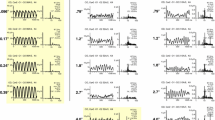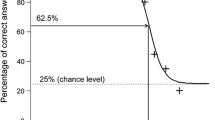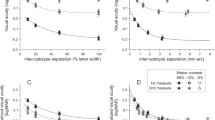Abstract
Purpose
To describe a novel optokinetic visual acuity estimator (Oktotype) and to report the preliminary results obtained in poorly and non-collaborative subjects.
Methods
Eleven series of symbols arranged horizontally and moving from left to right at a constant rate were displayed. In each sequence, the size of the stimuli was reduced logarithmically. By using this paradigm, the objective visual acuity was computed in 26 normal subjects as the minimum size of the symbols able to evoke the optokinetic response. In the preliminary phase, three contrast levels were tested, with white noise added to the first five sequences so as to normalize the overestimate found at the lower-half range of the acuity scale. Subsequently, the correspondence between subjective and objective visual acuity was compared in 10 poorly collaborative subjects, and the agreement between optokinetic and Teller visual acuity was measured in six non-collaborative subjects.
Results
The best agreement is provided by the minimum contrast level (20%) (R 2 = 0.74). The correspondence between the two techniques is satisfying both in the normal and in the poorly collaborative sample (concordance correlation coefficient: 0.85 and 0.83, respectively). In the non-collaborative group, the concordance correlation coefficient between Teller acuity and OKVA ranged between 0.79 (test) and 0.85 (retest). Test–retest reliability was very good for the Oktotype (K: 0.82), and better than the Teller test (K = 0.71), even if it was lower compared to Snellen acuity (K = 0.95).
Conclusion
The Oktotype seems promising to predict Snellen visual acuity in normal and poorly collaborative subjects.








Similar content being viewed by others
Notes
Stereo Optical Company—Teller acuity Cards ™ II (TAC II), Handbook, pag. 41, 2005.
Teller Acuity Card Manual, Dayton, OH: Vistech, Inc. 1990.
References
West SK, Munoz B, Rubin GS, Schein OD, Bandeen-Roche K, Zeger S, German PS, Fried LP (1997) Function and visua impairment in a population-based study of older adults. Opthalmol Vis Sci 38:72–82
Lam BL, Christ SL, Zheng DD, West SK, Munoz BE, Swenor BK, Lee DJ (2013) Longitudinal relationships among visual acuity and tasks of everyday life: the Salisbury Eye Evaluation study. Invest Ophthalmol Vis Sci 54:193–200
Levenson JH, Kozarsky A (1990) Visual acuity. In: Walker HK, Hall WD, Hurst JW (eds) Clinical methods: the history, physical, and laboratory examination, vol 3. Butterworth Ed, Boston
Teller DY (1979) The forced-choice preferential looking procedure: a psychophysical technique for use with human infants. Infant Behav Dev 2:135–153
McDonald MA, Dobson V, Sebris L, Baitch L, Varber D, Teller DY (1985) The acuity card procedure: a rapid test of infant acuity. Invest Ophthalmol Vis Sci 26:1158–1162
McDonald M, Sebris SL, Mohn G, Teller DY, Dobson V (1986) Monocular acuity in normal infants: the acuity card procedure. Am J Optom Physiol Opt 63:127–134
Courage ML, Adams RJ (1990) Visual acuity assessment from birth to three years using the acuity card procedure: cross-sectional and longitudinal samples. Optom Vis Sci 67:713–718
Fielder AR, Dobson V, Moseley MJ, Mayer DL (1992) Preferential looking-clinical lessons. Ophthalmic Paediatr Genet 13:101–110
Tyler CW, Apkarian P, Levi DM, Nakayama K (1979) Rapid assessment of visual function: an electronic sweep technique for the pattern visual evoked potential. Invest Ophthalmol Vis Sci 18:703–713
Bach M, Maurer JP, Wolf ME (2008) Visual evoked potential-based acuity assessment in normal vision, artificially degraded vision, and in patients. Br J Ophthalmol 92:396–403
Steele M, Seiple WH, Carr RE, Klug R (1989) The clinical utility of visual-evoked potential acuity testing. Am J Ophthalmol 108:572–577
Heine S, Rüther K, Isensee J, Zrenner E (1999) Clinical significance of objective vision assessment using visually evoked cortical potentials induced by rapid pattern sequences of different spatial frequency. Klin Monbl Augenheilk 215:175–181
Nakamura A, Akio T, Matsuda E, Wakami Y (2001) Pattern visual evoked potentials in malingering. J Neuroophthalmol 21:42–45
Gundiogan FC, Sobaci G, Bayer A (2007) Pattern visual evoked potentials in the assessment of visual acuity in malingering. Ophthalmology 114:2332–2337
Jeon J, Oh S, Kyung S (2012) Assessment of visual disability using visual evoked potentials. BMC Ophthalmol 12:36
Ridder VH, Tong A, Floresca T (2012) Reliability of acuities determined with the sweep visual evoked potential (sVEP). Doc Ophthalmol 124:99–107
Kurtenbach A, Langrová H, Messias A, Zrenner E, Jägle H (2013) A comparison of the performance of three visual evoked potential-based methods to estimate visual acuity. Doc Ophthalmol 126:45–56
Almoqbel F, Leat SJ, Irving E (2008) The technique, validity and clinical use of the sweep VEP. Ophthalmic Physiol Opt 28:393–403
Kothari R, Bokariya P, Singh S, Singh R (2016) A Comprehensive review on methodologies employed for visual evoked potentials. Scientifica. doi:10.1155/2016/9852194 (9852194)
Millodot M, Harper P (1969) Measure of visual acuity by means of eye movements. Optom Vis Sci 46:938–944
Kim MS, Choi YS, Lu WN, Lee K, Hwang GM, Wee WR, Lee JH (2000) The development of an objective test for visual acuity assessment using optokinetic nystagmus stimuli presented head-mounted display: sreohan objective visual acuity test. J Korean Ophthalmol Soc 41:871–878
Shin YJ, Park KH, Hwang JM, Wee WR, Lee JH, Lee IB (2006) Objective measurement of visual acuity by optokinetic response determination in patients with ocular diseases. Am J Ophthalmol 141:327–332
Wester ST, Rizzo JF, Balkwill MD, Wall C (2007) Optokinetic nystagmus as a measure of visual function in severely visually impaired patients. Invest Ophthalmol Vis Sci 48:4542–4548
Hyon JY, Yeo HE, Seo J, Lee IB, Lee JH, Jeong-Min Hwang J (2010) Objective measurement of distance visual acuity determined by computerized optokinetic nystagmus test. Invest Ophthalmol Vis Sci 51:752–755
Han SB, Yang HK, Hyon JY, Seo J, Lee JH, Lee IB, Hwang J (2011) Efficacy of a computerized optokinetic nystagmus test in prediction of visual acuity of better than 20/200. Invest Ophthalmol Vis Sci 52:7492–7497
Han SB, Han ER, Hyon JY, Seo JM, Lee JH, Hwang JM (2011) Measurement of distance objective visual acuity with the computerized optokinetic nystagmus test in patients with ocular diseases. Graefes Arch Clin Exp Ophthalmol 249:1379–1385
Quinn GE, Berlin JA, James M (1993) The Teller acuity card procedure. Three testers in a clinical setting. Ophthalmology 100:488–494
Getz LM, Dobson V, Luna B, Mash C (1996) Interobserver reliability of the Teller acuity card procedure in pediatric patients. Invest Ophthalmol Vis Sci 37:180–187
Mayer DL, Beiser AS, Warner AF, Pratt EM, Raye KN, Lang JM (1995) Monocular acuity norms for the Teller Acuity Cards between ages one month and four years. Invest Ophthalmol Vis Sci 36:671–685
Hertz BG, Rosenberg J (1992) Effect of mental retardation and motor disability on testing with visual acuity cards. Dev Med Child Neurol 34:115–122
Mash C, Dobson V, Carpenter N (1995) Interobserver agreement for measurement of grating acuity and interocular acuity differences with the Teller Acuity Card procedure. Vis Res 35:303–312
Mash C, Dobson V (2005) Intraobserver reliability of the Teller Acuity Card procedure in infants with perinatal complications. Optom Vis Sci 82:817–822
Hertz BG (1988) Use of the acuity card method to test retarded children in special schools. Child Care Health Dev 14:189–198
Vesely P (2015) Contribution of sVEP visual acuity testing in comparison with subjective visual acuity. Biomed Pap Med Fac Univ Palacky Olomouc Czech Repub 159:616–621
Ridder VH (2004) Methods of visual acuity determination with the spatial frequency sweep visual evoked potential. Doc Ophthalmol 109:239–247
Millodot M, Miller D, Jernigan ME (1973) Evaluation of an objective acuity device. Arch Ophthalmol 90:449–452
Khan SG, Chen KF, Frenkel M (1976) Subjective and objective visual acuity testing techniques. Arch Ophthalmol 94:2086–2091
Lin LI (1989) A concordance correlation coefficient to evaluate reproducibility. Biometrics 45:255–268
Altman DG (1991) Practical statistics for medical research. Chapman and Hall, London
Shrout PE, Fleiss JL (1979) Intraclass correlations: uses in assessing rater reliability. Psychol Bull 86:420–428
Arai M, Katsumi O, Paranhos FR, Lopes De Faria JM, Hirose T (1997) Comparison of Snellen acuity and objective assessment using the spatial frequency sweep VEP. Graefes Arch Clin Exp Ophthalmol 235:442–447
Teller DY, McDonald M, Preston K, Sebris S, Dobson V (1986) Assessment of visual acuity in infants and children: the Acuity Card procedure. Dev Med Child Neurol 28:779–789
Birch EE, Hale LA (1988) Criteria for monocular acuity deficit in infancy and early childhood. Invest Ophthalmol Vis Sci 29:636–643
Bouma H (1970) Interaction effects in parafoveal letter recognition. Nature 226:177–178
Gorman JJ, Cogan DG, Gellis SS (1957) An apparatus for grading the visual acuity of infants on the basis of optokinetic nystagmus. Pediatrics 19:1088–1092
Geer I, Robertson KM (1993) Measurement of central and peripheral dynamic visual acuity thresholds during ocular pursuit of a moving target. Optom Vis Sci 70:552–560
Ludvigh E, Miller JW (1953) A study of dynamic visual acuity. U.S. Naval School of Aviation Medicine. Res Report No. NM 001 075.01.01
Marx MS, Werner P, Fridman P, Cohen-Mansfield J (1989) Visual acuity estimates in the aged. Clin Vis Sci 4:179–182
Marx MS, Werner P, Cohen-Mansfield J, Hartmann EE (1990) Visual acuity estimates in noncommunicative elderly persons. Invest Ophthalmol Vis Sci 31:593–596
Eggert T (2007) Eye movement recordings: methods. Dev Ophthalmol 40:15–34
Towle VL, Harter MR (1977) Objective determination of human visual acuity: pattern evoked potentials. Invest Ophthalmol Vis Sci 16:1073–1076
Funding
No funding was received for this research.
Author information
Authors and Affiliations
Corresponding author
Ethics declarations
Conflict of interest
All authors certify that they have no affiliations with or involvement in any organization or entity with any financial interest (such as honoraria; educational grants; participation in speakers’ bureaus; membership, employment, consultancies, stock ownership, or other equity interest; and expert testimony or patent-licensing arrangements), or non-financial interest (such as personal or professional relationships, affiliations, knowledge, or beliefs) in the subject matter or materials discussed in this manuscript.
Ethical approval
All procedures performed in studies involving human participants were in accordance with the ethical standards of the institutional and/or national research committee and with the 1964 Helsinki Declaration and its later amendments or comparable ethical standards.
Informed consent
Informed consent was obtained from all individual participants included in the study.
Rights and permissions
About this article
Cite this article
Aleci, C., Scaparrotti, M., Fulgori, S. et al. A novel and cheap method to correlate subjective and objective visual acuity by using the optokinetic response. Int Ophthalmol 38, 2101–2115 (2018). https://doi.org/10.1007/s10792-017-0709-x
Received:
Accepted:
Published:
Issue Date:
DOI: https://doi.org/10.1007/s10792-017-0709-x




